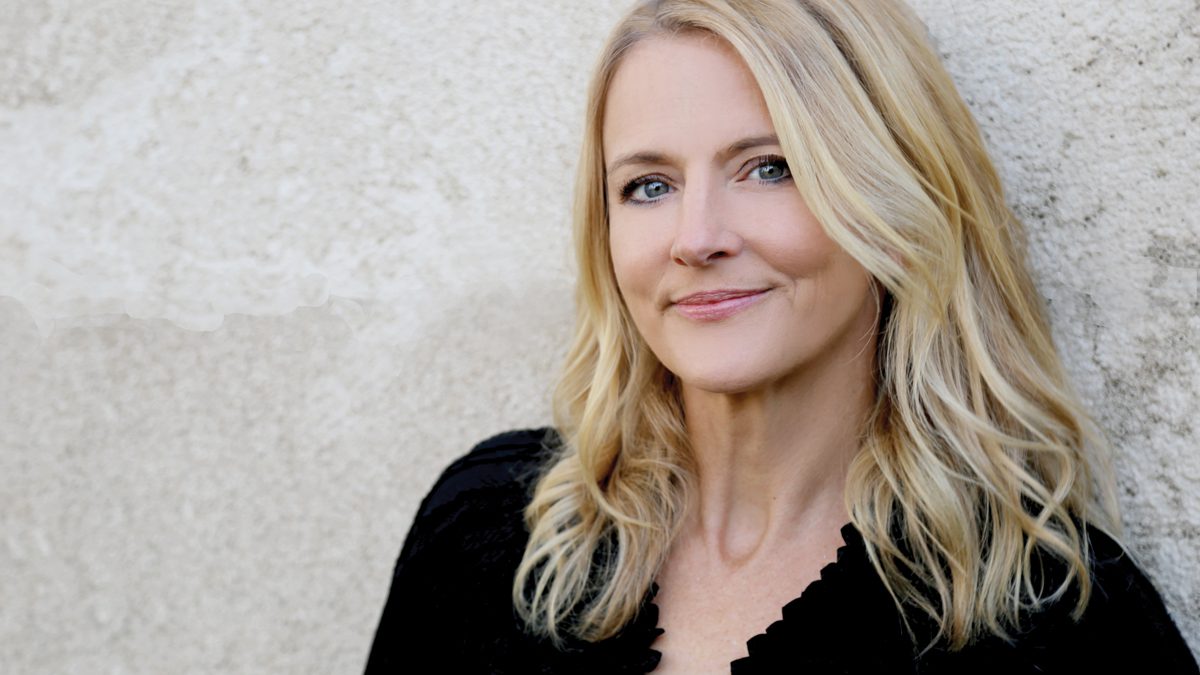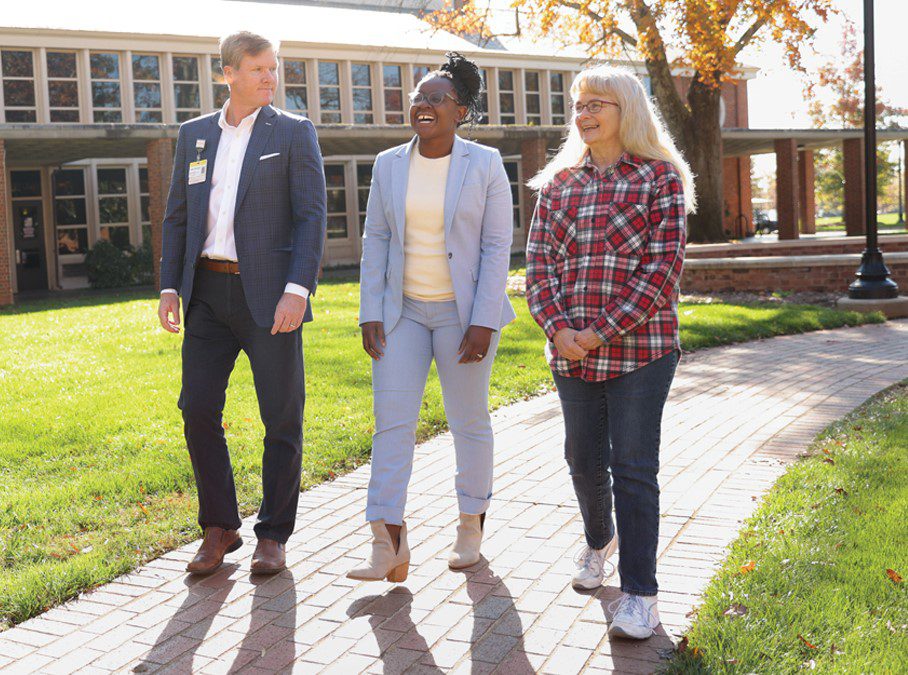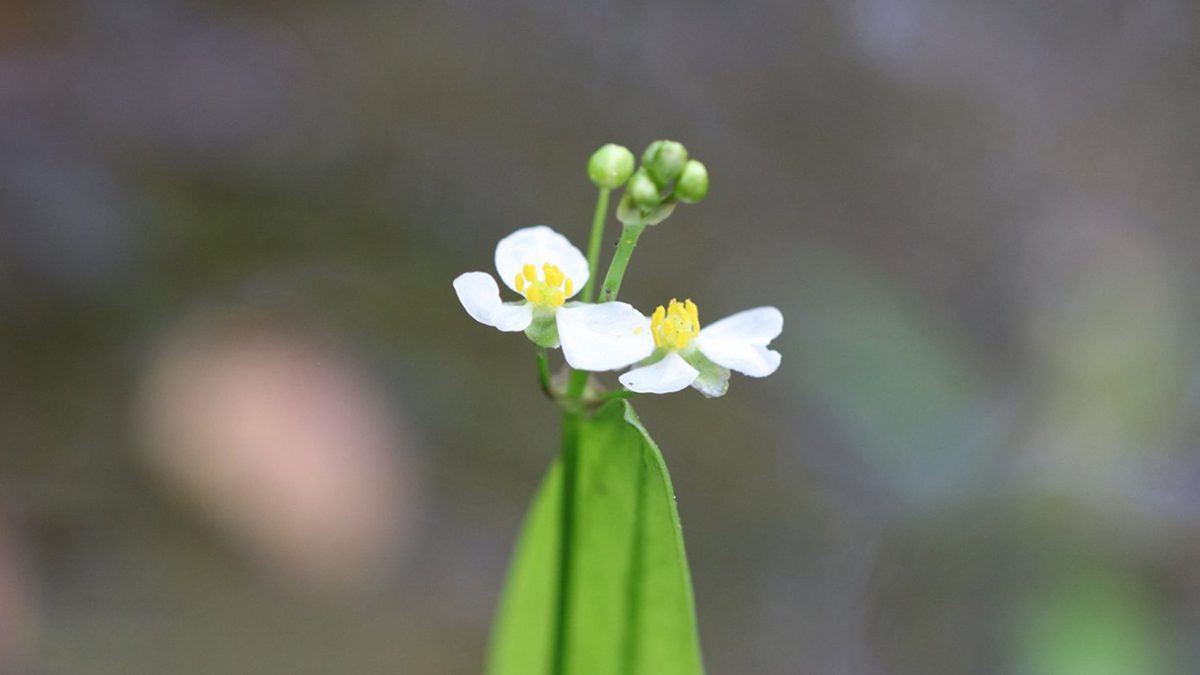
Feature
The ‘Every Plant’ Is Us
It’s rare and precious. And completely nondescript.
By Sarita Chourey
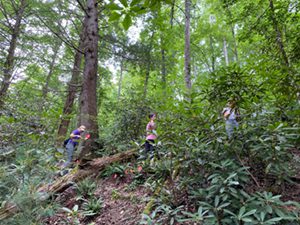
Lauren Eberth ’23, Skyler Fox ’22 and Calla Pederson ’23 in Pisgah National Forest in Summer 2021, taking part in Associate Professor of Biology Ashley Morris’s research. / Ashley Morris
The pitcher plant swallows frogs. The kudzu vine shrouds entire landscapes. The bunched arrowhead, finally getting through to customer service, says, “Oh, hello! I’m calling because – Yes, I’ll hold.” And then does so, humming softly. As if it has nowhere special to be.
But, you see, the bunched arrowhead itself is special. So special that in 2012, someone stole 60 of the plants from northern Greenville County. So special that some experts weighed whether to be interviewed for this article. Would it attract another thief or the unwanted foot traffic of admirers?
To look closely at the bunched arrowhead is to look closely at ourselves. Do you ever wonder if you are special? Do you realize that, statistically speaking, you probably are not? Take a lesson from the bunched arrowhead, a foot-tall plant with white flowers and a love of bogs: You can be both. Extremely rare and beloved, yet nondescript, an overlooked cog in something larger.
The federally endangered bunched arrowhead is found in two U.S. states – North and South Carolina – and nowhere else in the world. However, most of the North Carolina populations are now extinct, says retired Furman Biology Professor Joe Pollard. And of those in South Carolina, Furman is home to one of the few remaining populations.
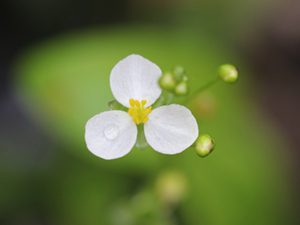
Bunched arrowhead / Ashley Morris
The people in the town
Lindsey Beard ’13 spent months among the plants before determining in her research that the bunched arrowhead needs stable water levels to survive. While a student and after graduating, she lived next to the Swamp Rabbit Trail and would bring visiting family members to admire the bunched arrowhead nearby.
“Their first response was always, ‘What does this plant do?’” says Beard, who today gathers and analyzes water samples as a laboratory technician at Mount Pleasant Waterworks near Charleston, South Carolina.
“They loved it because I loved it,” she says. “But they were a little bit like, ‘Why are you studying this plant because it looks like a weed?’” Beard’s family wasn’t wrong. The bunched arrowhead is “the every plant,” as described by Furman Biology Professor Wade Worthen. To say so is only to refuse to patronize it.
“We’re often caught up by the stories of the charismatic species – lions, tigers and bears, which are absolutely extraordinary organisms and worthy in several ways of our protection,” says Worthen, the Rose J. Forgione Professor of Biology. “But here we have this small, unobtrusive, very simple little aquatic plant. The flowers aren’t beautiful. There’s nothing really about this plant that is remarkable in any way.”
Just like most of us, of course. And yet, we’re worthy of respect and consideration, and even admiration, depending on the sensibilities of the crowd.
“For most folks who don’t perceive themselves as global leaders or extraordinary in a particular sense, they still understand the value and contributions that individuals make to entire communities,” says Worthen. “And that’s what this plant does, as well.”
Similarly, some may see a forest and perceive only a mass of vegetation. But Worthen urges us to consider the complex interactions between the organisms that live there.
“A forest is the individual species within it. That’s what makes up a forest,” he says. “What makes up a town? It’s the people in it, the people who live there. If nobody lives there, you don’t have a town anymore.”
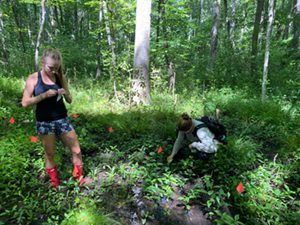
Nora Tillmanns ’23 and Banks Floyd ’22 at Blackwell State Historical Preserve in Summer 2021 / Ashley Morris
‘No one moved and no one spoke’
Beard’s experience is one of many at Furman, a place where saying, “Tell me your bunched arrowhead story” can get a surprising number of people talking.
Travel back to a spring day in the late 1980s.
Gillian Newberry, a biology professor at the University of South Carolina Upstate, is coated in “tannish ooze” as she crawls through a muddy seep off of Furman Lake, the smell of sulfur in her nostrils. She is conducting a three-year study of all known populations of the bunched arrowhead, including Furman’s.
“Crawling through the mud on my hands and knees allowed me to sink only about a foot into the quagmire,” Newberry, now retired, recalls in her published reflections.
“Using this method, I could propel myself through the mud and liberate the weeds,” which were crowding the bunched arrowhead.
That’s when she feels the eyes.
A formal wedding party is staring down at her from their picnic reception.
“No one moved and no one spoke,” remembers Newberry, who then gave her audience “a small, muddy wave.”
About 15 years later, Furman students raised money to construct a bunched arrowhead observation deck with educational signs. And today Ashley Morris, associate professor of biology at Furman, is researching whether the bunched arrowhead at Furman is even more rare – whether it is the product of sexual reproduction or whether it’s a single plant that cloned itself.
“If every individual you see in the Furman population is genetically identical, that could be really bad for its ability to respond to changes in the environment,” such as a pest or pathogen, says Morris.

Wade Worthen, the Rose J. Forgione Professor of Biology
A thread too many
The bunched arrowhead hasn’t always received such scrutiny. Botanist Jared Gage Smith suggested in 1899 that it was a new, distinct species. But he never made it official. And so for decades, specimens – despite their differences – continued to be classified as a related species from the region. Finally, in 1960, Earnest Beal, a professor at North Carolina State University, declared it the Sagittaria fasciculata, a never before identified species that we now know as bunched arrowhead.
And so the little plant, which looks and acts nothing like a fistful of weapons, poked up from anonymity only to find itself in a perilous world today. Piedmont Natural Gas is trying to build a pipeline through northern Greenville County, which could put the plant at risk, even as everyday development endangers it and other natural inhabitants.
What does it matter? Don’t we always need more drive-thrus and shopping plazas? Who can halt the sprawl of new homes? What’s one bird species or one plant or one tree species?
“Oftentimes, people lose sight of the trees for the forest,” says Worthen. “If we lose the plant, it may not have any important function in the ecology of these small, isolated little seepage areas. But what we’re finding is that eventually you’ll pull out a thread that’s tied to so many others, and the community will no longer hold.”
We don’t know when we may pull that thread.
To support plant conservation research at Furman, go to furman.edu/plants.
